ABSTRACT
P-dipping is a practical approach for smallholder farmers to increase lowland rice yields with minimal fertilizer inputs by coating seedling roots with P-enriched slurry at transplanting. The effect of such localized application increases by concentrating more nutrients near the roots; however, this also increases the risk of salt stress known as fertilizer burning. The study aimed to identify the effect and burning risk of P-dipping on the initial rice growth under a range of temperatures. Rice seedlings were dipped instantly or for 2 h in slurry with different P2O5 concentrations at 0% (P0), 2.3% (P1), and 4.4% (P2), transplanted with the slurry attached to the seedling roots, and grown for 21–28 days at the day/night temperatures of 28°/20°C, 33°/25°C, and 36°/27°C. A significant interaction effect was detected between the P2O5 concentrations and growing temperatures on shoot biomass. With the P-dipping treatments, shoot biomass was increased 4.8–5.2 times at 28°/20°C. The effect of P-dipping became less significant with increasing temperatures because of the greater rates of withered leaves soon after transplanting. Burning damage was the greatest when the P2 treatment was combined with longer dipping duration at the 36°/27°C, nullifying the effect of P-dipping on shoot biomass. The results clearly showed that localized P application is more effective under lower temperatures, with lower risk of fertilizer burning. Elevated temperatures may disturb the effort to increase rice yields with minimal fertilizer inputs via localized application.
GRAPHICAL ABSTRACT
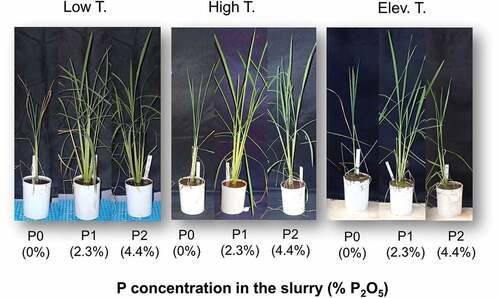
Introduction
Localized micro-dose fertilizer management is a practical approach for increasing crop yields with minimal fertilizer inputs. It refers to the placement of small amounts of nutrients, e.g. a bottle capful or three-finger pinch of fertilizer, in a planting hole and in a band close to the planting area, instead of broadcasting fertilizers (Twomlow et al., Citation2010). For the transplanted rice production system, dipping seedling roots into P-enriched slurry at the time of transplanting (also known as P-dipping) is a practical technique for localizing P around the roots (Rakotoson et al., Citation2022). This approach is affordable and is appealing for smallholder farmers in sub-Saharan Africa (SSA), as they have little financial capacity to purchase commercial fertilizers (Aune et al., Citation2007; Hayashi et al., Citation2008; Ibrahim et al., Citation2015). In addition, the methods of fertilizer application aiming to achieve a high nutrient use efficiency are increasingly important at a global scale for simultaneously addressing the growing food demands and reducing environmental impacts (Aune & Bationo, Citation2008; Tsujimoto et al., Citation2019; Vandamme et al., Citation2018).
Several studies have reported the positive impacts of localized micro-dose fertilizer application with significant increases in grain yields and nutrient use efficiency for maize (Tovihoudji et al., Citation2017), millet (Aune et al., Citation2007), sorghum (Adams et al., Citation2016), and upland rice (Vandamme et al., Citation2018) in SSA. Similarly, P-dipping at the application rate of 30 kg P2O5 ha−1 was reported to significantly increase rice grain yields by 10–50% with the same application rates or the same yield levels with 40–60% reductions in P application rates relative to broadcasting or incorporating P at transplanting (Balasubramanian et al., Citation1994; De Datta & Charoenchamratcheep, Citation1990; Raju et al., Citation1980; Ramanathan & Kothandaraman, Citation1984). Recent studies have demonstrated that the effect of P-dipping was particularly large when there was a risk of encountering low-temperature stress during the reproductive stage because of its significant impact to shorten the growth durations, as well as in soils with high P-fixation capacity (Oo, Tsujimoto, Rakotoarisoa, et al., Citation2020; Rakotoarisoa et al., Citation2020). The P-dipping technique is currently being disseminated to hundreds of rice farmers in the central highlands of Madagascar where both P deficiency and low-temperature stress restrict rice yields (Rakotoson et al., Citation2022).
However, one technical drawback of a series of localized nutrient applications is the potential risk of fertilizer burning associated with high salt concentrations around the root zone (Aune et al., Citation2007; Muehlig-Versen et al., Citation2003; Vandamme et al., Citation2018). Muehlig-Versen et al. (Citation2003) observed a detrimental effect of single super phosphate (SSP) on the seedling survival rate when 1.3 g of it was directly applied to the planting hole with millet seeds, and the effect of fertilizer burning on seedling emergence was further exacerbated by post-sowing drought stress. Likewise, Vandamme et al. (Citation2018) observed a reduced plant survival rate after seedling emergence when applying localized P in a planting hole for upland rice cultivation; they suggested to avoid this practice in dry and sandy soils. In addition, our preliminary field observations in the central highlands of Madagascar implied that fertilizer burning or slow recovery of rice transplanted after P-dipping is more significant in warmer environmental conditions. Previous studies on localized P application have indicated that the risk of fertilizer burning is high when P application is followed by post-planting drought stress, but no studies have evaluated the interaction effect between localized nutrient application and post-planting temperatures on plant growth. The understanding of such interactions with environmental conditions related to the risk of fertilizer burning would encourage farmers to apply this technique and increase the benefits from these practices. In addition, the interaction between fertilizer management and growing temperature is also important to understand given the increasing concern about the impact of global warming on sustainable crop production.
The present study aimed to identify the positive effect and burning risk of localized P application in lowland rice production under a range of temperature conditions. Based on our preliminary observations, we hypothesized that lower temperature during plant growth after the P-dipping treatment can reduce the risk of fertilizer burning and maximize the benefit of localized P application via P-dipping for subsequent rice growth.
Materials and methods
Experimental design
A pot experiment was conducted in a controlled growth chamber (Biotron LPH-1P-SH, Nippon Medical and Chemical Instruments Co. Ltd., Japan) at the Japan International Research Center for Agricultural Science (JIRCAS), Tsukuba, Japan. The experimental soil used in this study was volcanic soil collected from the forest subsoil layer (at the depth of 20–40 cm) without any P fertilization records within the experimental farm of JIRCAS. The experimental soil had low oxalate-extractable P contents at 400 mg kg−1 and high P-fixing capacity at 99%. The other physicochemical properties are summarized in Oo, Tsujimoto, Rakotoarisoa, et al., Citation2020. One-liter plastic pots were filled with 1 kg of soil after sieving and passing it through an 8.0 mm sieve. In all pots, NH4NO3 and K2SO4 were applied to the soil at the rates of 100 mg N pot−1 and 100 mg K pot−1, respectively, before transplanting, to exclude the possible effects of N and K deficiency.
Afterwards, slurry with three different levels of P2O5 concentrations, i.e. 0%, 2.3%, and 4.4% by weight (hereafter P0, P1, and P2, respectively), was prepared by mixing 100 g of soil, 50 mL of distilled water, and 0 g, 8.7 g, and 17.4 g of triple super phosphate (42% P2O5), respectively. A common and high-yielding rice variety in the highlands of Madagascar, X265, (Oryza sativa), was used. Twenty-one-day-old rice seedlings were dipped in each slurry for two different durations, i.e. 0 h (a short dipping for a few minutes) and 2 h, before transplanting. A factorial combination of three P concentrations and two dipping durations with six replicates were prepared in the same manner, and rice plants were grown in flooded soil under three different temperature conditions with the day/night temperatures of 28°/20°C (Low T), 33°/25°C (High T), and 36°/27°C (Elev. T). Daylength was consistently set at 14 h in the Biotron, which was equipped with 12 ceramic metal halide lamps (M360CELSP-W/BUD, IWASAKI, Tokyo).
Measurements
At six days after transplanting, the percentages of withered portions of the top two or 3rd and 4th leaves were calculated by dividing the length of the withered portions by the whole length of each leaf, and this represented an index of chemical injury after transplanting. Aboveground shoots were sampled at around cumulative temperature from transplanting at 672°C, which was 28, 23, and 21 days after transplanting for Low T, High T, and Elev. T, respectively. At the sampling, the number of tillers and leaf number on the main stem were measured according to Tsujimoto et al. (Citation2020). Shoot samples were dried at 70°C for three days to determine the shoot biomass (g pot−1). Shoot P concentration was analyzed using the molybdate blue method after dry ashing at 550°C for 2 h and digestion with 0.5 M HCl (Murphy & Riley, Citation1962). Shoot P uptake (mg pot−1) was calculated by multiplying the shoot biomass and shoot P concentration. Immediately after the shoots were sampled, soil was carefully washed off the roots using a 2 mm sieve. After removing the soil from the roots, total root length (cm plant−1) was measured using the Epson Pro-selection X980 scanner and WinRhizo Pro software (Regent Instruments, Quebec, Canada). Subsequently, the roots were dried in an oven at 70°C for three days to determine the root biomass (g pot−1).
Statistical analysis
Statistical analysis of the data was performed using the JMP software (v14.0.0, SAS Institute Inc., Japan). The data were analyzed by three-way analysis of variance (ANOVA) to assess the single and interaction effects of P concentrations in the slurry, dipping durations, and temperature conditions on the measured variables. The replicate was treated as a random factor within each temperature condition. A post-hoc mean comparison was performed using Tukey’s Honestly Significant Difference (HSD) test at P < 0.05.
Results
Effect of P-dipping on rice shoot biomass and P uptake under different temperatures
The ANOVA detected significant interaction effects between the P treatment and temperature on both shoot biomass and shoot P uptake (). As there were no significant interactions among the three factors, i.e. P treatment, temperature, and dipping duration, on either shoot biomass or shoot P uptake, the means of the dipping duration were compared among P treatments and temperature conditions in . Under the P0 treatment or without P-dipping, there were no significant differences in either shoot biomass or shoot P uptake among the growing temperatures. The P1 treatment significantly increased the shoot biomass at all temperature conditions, and the increase rates were greater in the order of Low T > High T > Elev. T. When the P concentration of the slurry was increased from P1 to P2, the shoot biomass was slightly reduced by 8% under Low T condition and by 18% under High T condition (). The biomass reduction was fairly large (by 62%) from P1 to P2 under the Elev. T condition, which nullified the effect of the P-dipping treatment. The difference in shoot biomass between P0 and P2 was not significant under the Elev. T condition. Likewise, the effect of P-dipping and that of higher P concentration in the slurry on the shoot P uptake was greater under lower temperature conditions (). Under Low T, the shoot P uptake after the P-dipping treatment significantly increased by increasing the amounts of P applied (P2 > P1). Under High T, the effect of P-dipping on the shoot P uptake plateaued from P1 to P2. Under Elev. T, the shoot P uptake after the P-dipping was reduced by 25% at the higher P application rate compared to that at the lower P application rate.
Figure 1. Rice shoot biomass (a) and shoot P uptake (b) at around cumulative growing degree days of 672°C after transplanting as affected by different temperatures (Low T, high T, Elev. T) and P2O5 concentrations in the slurry (0%, 2.3%, and 4.4% for P0, P1, and P2, respectively). Data are shown as mean values of 0 h and 2 h dipping durations. Different letters indicate that mean values were significantly different among the treatments at 5% according to Tukey’s HSD test. Day/night temperature; 28°/20°C in Low T, 33°/25°C in High T, 36°/27°C in Elev. T.
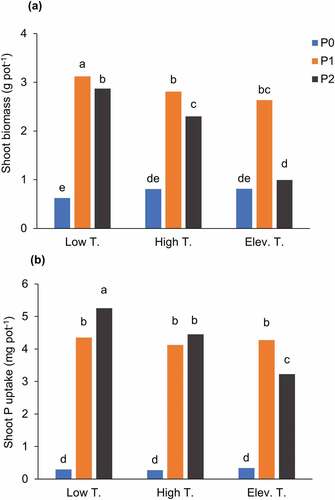
Table 1. Levels of significance in F statistics for the effect and interaction of temperature, P2O5 concentration in slurry, and dipping duration on the measured variables.
A significant interaction effect between temperature and dipping duration on shoot biomass was observed. Shoot biomass did not significantly differ between 0 h and 2 h treatments under the Low T and High T conditions (Supplementary Table S1). On the other hand, it was significantly lower after 2 h of P-dipping than after 0 h of P-dipping under the Elev. T condition.
Effect of P-dipping on post-transplanting leaf damages, leaf growth, and tillering of rice under different temperatures
The ANOVA detected significant interaction effects between the P treatment and temperature on the withered percentage of the top (4th) leaf at six days after transplanting (). Under the P0 treatment, leaf withering of the 4th leaf was not commonly observed, irrespective of the temperature conditions (). Under the P1 treatment, the percentages of withered portion of the top leaf were significantly increased at 15% under the High T and at 22% under the Elev. T conditions. Under the P2 treatment, leaf withering was further exacerbated at 57% under the High T and 87% under the Elev. T conditions. On the other hand, under the Low T condition, the 4th leaf did not wither after P-dipping irrespective of the amount of P applied. Likewise, the percentage of the withered portion of the 3rd leaf after P-dipping was more severe under higher temperature conditions and higher amounts of P applied: at 8% under the Low T, 27% under the High T, and 47% under the Elev. T conditions with P1, and at 31% under the Low T, 66% under the High T, and 88% under the Elev. T conditions with P2 (). It should be noted that the percentage of the withered portion of the 3rd leaf was slightly but significantly higher under the Elev. T than under the other temperature conditions, even without the P-dipping treatment (P0) particularly when the dipping duration was prolonged at 2 h (Suplementary Figure S1). The interaction among P treatment, temperature, and dipping duration were significant on the withered portion of the 3rd leaf ().
Figure 2. Percentages of withered portions of the 4th (a) and 3rd leaves (b) at six days after transplanting as affected by different temperatures (Low T, High T, Elev. T) and P2O5 concentrations in the slurry (0%, 2.3%, and 4.4% for P0, P1, and P2, respectively). Data are shown as mean values of 0 h and 2 h dipping durations. Different letters indicate that mean values were significantly different among the treatments at 5% according to Tukey’s HSD test. Day/night temperature; 28°/20°C in Low T, 33°/25°C in High T, 36°/27°C in Elev. T.
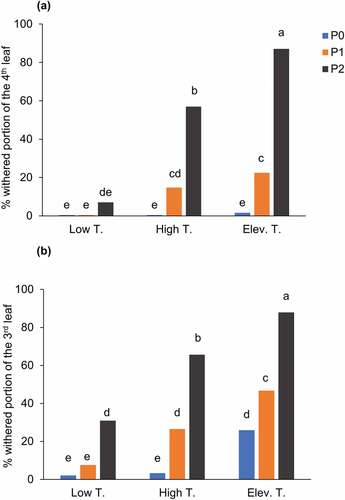
The number of tillers and leaf age at the time of sampling were also affected by the interaction between the P treatment and temperature (). The number of tillers did not differ across the temperature conditions without P-dipping (P0). The P-dipping treatments (both P1 and P2) increased the number of tillers at the greatest rates under the Low T condition (). On the other hand, under the High T and Elev. T conditions, the number of tillers were greater in the order of P1 > P2 > P0. Under the Elev. T condition, there was no significant difference in the number of tillers between P2 and P0. Under the Low T and High T conditions, the leaf number increased by 2.4–2.6 after P-dipping irrespective of the amount of P applied (). Under the Elev. T condition, the leaf number increased with P1, but decreased by increasing the amounts of P applied from P1 to P2.
Figure 3. Number of tillers (a) and leaf age (b) at around cumulative growing degree days of 672°C after transplanting as affected by different temperatures (Low T, High T, Elev. T) and P2O5 concentrations in the slurry (0%, 2.3%, and 4.4% for P0, P1, and P2, respectively). Data are shown as mean values of 0 h and 2 h dipping durations. Different letters indicate that mean values were significantly different among the treatments at 5% according to Tukey’s HSD test. Day/night temperature; 28°/20°C in Low T, 33°/25°C in High T, 36°/27°C in Elev. T.
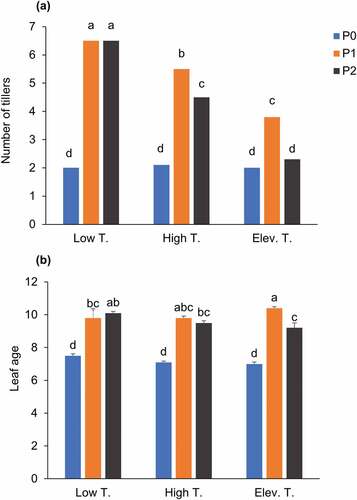
Effect of P-dipping on rice root biomass and total root length under different temperatures
The root biomass and total root length were also affected by the interaction between the P-treatment and temperature (). Without P-dipping (P0), the root biomass was relatively high under the Elev. T and High T conditions compared to the Low T condition (). The root mass was significantly increased with P-dipping for both P1 and P2 under the Low T condition. However, under the High T condition, the root mass was increased only with P1. Under the Elev. T condition, the root mass was negatively affected by P-dipping and significantly reduced from 0.43 g pot−1 under P0 to 0.12 g pot−1 under P2. Similarly, the positive effect of P-dipping on total root length was most significant under the Low T condition (). P-dipping nearly doubled the total root length at P1 under the Low T condition. On the other hand, P-dipping negatively affected total root length under the Elev. T condition, and severely reduced the value from 142.9 cm pot−1 without P-dipping to 46.6 cm pot−1 under P2. A significant interaction effect between temperature and dipping duration on root mass was observed; the root mass tended to be lower (but not significantly lower) when the dipping duration was longer under the Elev. T condition (Supplementary Table S1).
Figure 4. Root biomass (a) and total root length (b) at around cumulative growing degree days of 672°C after transplanting as affected by different temperatures (Low T, High T, Elev. T) and P2O5 concentrations in the slurry (0%, 2.3%, and 4.4% for P0, P1, and P2, respectively). Data are shown as mean values of 0 h and 2 h dipping durations. Different letters indicate that mean values were significantly different among the treatments at 5% according to Tukey’s HSD test. Day/night temperature; 28°/20°C in Low T, 33°/25°C in High T, 36°/27°C in Elev. T.
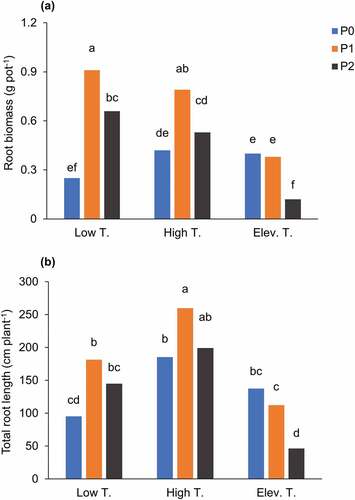
Discussion
Our results supported the hypothesis that the localized phosphorus application via P-dipping is more effective for increasing rice biomass and P uptake under lower temperature conditions with less fertilizer burning of rice seedlings after transplanting. This observation partly explains the finding of Rakotoarisoa et al. (Citation2020) that the effect of P-dipping was greater in sites with higher elevation and low temperature. In the conditions of the amount of slurry at approximately 2.3 g per hill attached to the seedling roots (Oo, Tsujimoto, Rakotoarisoa, et al., Citation2020) and a typical hill spacing of 20 × 20 cm, the P application rates of P1 and P2 were roughly estimated at 13 kg P2O5 ha−1 and 25 kg P2O5 ha−1 on a field scale. Accordingly, P-dipping at the rate up to 25 kg P2O5 ha−1 may be applied with a low risk of fertilizer burning under low-temperature conditions. In contrast, the risk of fertilizer burning after P-dipping increases under higher temperature conditions. Although being consistent at 36°/27°C during the day/night sounds rather extreme, the global warming scenario indicated that the global mean surface temperature would increase from 3.7 to 4.8°C by 2100 (Pachauri & Meyer, Citation2014), which can result in such growing conditions in the tropics, the major rice-producing area.
Severe fertilizer burning to plants after transplanting under higher temperature and higher P application rates can be associated with a transplanting shock combined with salt stress. Seedling roots are generally injured by transplanting and lose the balance between water uptake and transpiration, leading to leaf wilting and death within several days after transplanting (Kotera et al., Citation2004; Yamamoto, Citation1989). High evaporation demand and high rates of maintenance respiration under high temperatures can exacerbate the transplanting shock (Amthor et al., Citation2019). In the present study, the single effect of high temperature without P-dipping on such transplanting shocks was probably represented by a slightly higher withered rate of the top leaf in the Elev. T condition than that in the other conditions (), but this damage did not have any negative impacts on subsequent rice growth, as no significant differences in either shoot biomass or shoot P uptake were detected among different temperatures under P0 (). However, in combination with P-dipping, the negative impact of higher temperatures became clearer because the high concentration of P near the roots should have further disturbed the plant water or nutrient uptake as is the occurrence of salt stress (Hasegawa et al., Citation2000). Oo et al. (Citation2021) reported that P-dipping creates a hotspot of water-soluble P at the rate of 30 mg L−1 (>100 times greater than the critical P concentration of 0.2 mg L−1 for optimum rice growth) (Khalid et al., Citation1977; Roy & De Datta, Citation1985) near the seedling roots soon after transplanting, which enables a continuous supply of P to plants. However, increased osmotic pressure near the roots combined with high temperature could have induced severe damage to the top leaves after transplanting and subsequently led to significant reductions in root mass () and limitations of tillering (). Lee et al. (Citation2021) also showed that root damage from the transplanting shock inhibits tiller development. The results of the present study corresponded with our field observation that P-dipping tended to cause a prolonged growth stagnation and yellower leaves, particularly in warm climate conditions in the central highlands of Madagascar.
Our previous study indicated that the positive effect of P-dipping on initial rice growth and P uptake were reduced when the dipping duration was greater than 4 h (Oo, Tsujimoto, Rakotoarisoa, et al., Citation2020). Findings of the present study were consistent with this previous observation in the aspect that the post-transplanting leaf damages and subsequent shoot growth after P-dipping were not affected by the dipping duration of no more than 2 h. However, initial shoot P uptake was significantly reduced when the plants were dipped in the higher P concentration for 2 h compared to that in the plants transplanted instantly after short P-dipping (Data not shown). Therefore, it is always safer to keep the dipping duration as short as possible for applying the P-dipping technique. Under the Elev. T condition, longer dipping duration also negatively affected the shoot and root biomass irrespective of the P treatment (Table S1). This is most likely not because of the damage from the fertilizer burning with localized P application but is rather a consequence of the drought stress, which kept the uprooted seedlings under a high transpiration demand.
Conclusion
Our study clearly shows that the effect of localized P application via P-dipping on the initial rice growth and P uptake differs depending on the growing temperature conditions. The finding of favorable performance of P-dipping under lower temperature conditions should aid smallholder farmers in applying these relatively labor-intensive but resource-efficient fertilizer management practices in Madagascar. On the other hand, the high risk of fertilizer burning with P-dipping under elevated temperature conditions implied that the trend of global warming may interfere with such an effort to increase rice yields with minimal fertilizer inputs via localized nutrient application. Our findings can guide farmers how to apply these nutrient-use efficient but slightly labor-intensive techniques most effectively under the current and future climate conditions. How these post-transplanting risks of fertilizer burning after localized nutrient application affect rice grain yields need to be further investigated on a field scale.
Acknowledgement
The authors are grateful to Ms. Mayumi Yonemura for chemical analysis of soils and plants.
Disclosure statement
No potential conflict of interest was reported by the author(s).
Data availability statement
The datasets generated during and/or analyzed during the current study are available from the corresponding author on reasonable request.
Additional information
Funding
References
- Adams, A. M., Gillespie, A. W., Kar, G., Koala, S., Ouattara, B., Kimaro, A. A., Bationo, A., Akponikpe, P. B. I., Schoenau, J. J., & Peak, D. (2016). Long term effects of reduced fertilizer rates on millet yields and soil properties in the West-African Sahel. Nutrient Cycling in Agroecosystems, 106(1), 17–29. https://doi.org/10.1007/s10705-016-9786-x
- Amthor, J. S., Bar-Even, A., Hanson, A. D., Millar, A. H., Stitt, M., Sweetlove, L. J., & Tyerman, S. D. (2019). Engineering strategies to boost crop productivity by cutting respiratory carbon loss. The Plant Cell, 31(2), 297–314. https://doi.org/10.1105/tpc.18.00743
- Aune, J. B., & Bationo, A. (2008). Agricultural intensification in the Sahel – the ladder approach. Agricultural System, 98(2), 119–125. https://doi.org/10.1016/j.agsy.2008.05.002
- Aune, J. B., Doumbia, M., & Berthe, A. (2007). Microfertilizing sorghum and pearl millet in Mali: Agronomic, economic and social feasibility. Outlook on agriculture, 36(3), 199–203. https://doi.org/10.5367/000000007781891504
- Balasubramanian, V., Ratsimandresy, J., Razafinjara, A. L., & Rabeson, R. (1994). Phosphorus use efficiency in rice soils of the central highlands of Madagascar. Transactions of the XV International Congress on Soil Science, 5, 371–372. 10–16 July 1994 Acapulco, Mexico
- De Datta, S. K., & Charoenchamratcheep, C. (1990). Phosphorus requirements and management for lowland rice. Phosphorus requirements for sustainable agriculture in Asia and Oceania. Proceedings of a Symposium. International Rice Research Institute, Manila, Philippines, pp. 307–324, 6-10 March 1989.
- Hasegawa, P. M., Bressan, R. A., Zhu, J., & Bohnert, H. J. (2000). Plant cellular and molecular responses to high salinity. Annual Review of Plant Physiology and Plant Molecular Biology, 51(1), 463–499. https://doi.org/10.1146/annurev.arplant.51.1.463
- Hayashi, K., Abdoulaye, T., Gerard, B., & Bationo, A. (2008). Evaluation of application timing in fertilizer micro-dosing technology on millet production in Niger, West Africa. Nutrient Cycling in Agroecosystems, 80(3), 257–265. https://doi.org/10.1007/s10705-007-9141-3
- Ibrahim, A., Abaidoo, R. C., Fatondji, D., & Opoku, A. (2015). Hill placement of manure and fertilizer micro-dosing improves yield and water use efficiency in the Sahelian low input milled-based cropping system. Field Crop Research, 180, 29–36. https://doi.org/10.1016/j.fcr.2015.04.022
- IPCC. (2014). Climate change 2014: Synthesis report. In Pachauri, R. K. and Meyer, L. A. (Eds.), Contribution of working groups i, ii and iii to the fifth assessment report of the intergovernmental panel on climate change [core writing team (p. 151). IPCC.
- Khalid, R. A., Patrick, W. H., Jr., & Delaune, R. D. (1977). Phosphorus sorption characteristics of flooded soils. Soil Science Society of American Journal, 41(2), 305–310. https://doi.org/10.2136/sssaj1977.03615995004100020026x
- Kotera, A., Nawata, E., Chuong, P. V., Giao, N. N., & Sakuratani, T. (2004). A model for phenological development of vietnamese rice influenced by transplanting shock. Plant production science, 7(1), 62–69. https://doi.org/10.1626/pps.7.62
- Lee, H., Hwang, W., Jeong, J., Yang, S. Y., Jeong, N., Lee, C., & Choi, M. (2021). Physiological causes of transplantation shock on rice growth inhibition and delayed heading. Scientific Reports, 11(1), 16818. https://doi.org/10.1038/s41598-021-96009-z
- Muehlig-Versen, B., Buerkert, A., Bationo, A., & Roemheld, V. (2003). Phosphorus placement on acid arenosols of the west African Sahel. Experimental Agriculture, 39(3), 307–325. https://doi.org/10.1017/S0014479703001261
- Murphy, J., & Riley, J. P. (1962). A modified single solution method for the determination of phosphate in natural waters. Analytica Chemica Acta, 27, 31–36. https://doi.org/10.1016/S0003-2670(00)88444-5
- Oo, A. Z., Tsujimoto, Y., Mukai, M., Nishigaki, T., Takai, T., & Uga, Y. (2021). Synergy between a shallow root system with a DRO1 homologue and localized P application improves P uptake of lowland rice. Scientific reports, 11(1), 9484. https://doi.org/10.1038/s41598-021-89129-z
- Oo, A. Z., Tsujimoto, Y., & Rakotoarisoa, N. M. (2020). Optimizing the phosphorus concentration and duration of seedling dipping in soil slurry for accelerating the initial growth of transplanted rice. Agronomy, 10(2), 240. https://doi.org/10.3390/agronomy10020240
- Oo, A. Z., Tsujimoto, Y., Rakotoarisoa, N. M., Kawamura, K., & Nishigaki, T. (2020). P-dipping of rice seedlings increases applied P use efficiency in high P-fixing soils. Scientific reports, 10(1), 11919. https://doi.org/10.1038/s41598-020-68977-1
- Raju, S. A., Rao, M. M. G. V., Sathe, A., & Rao, S. I. V. (1980). Root dipping: A technique to supply P to lowland rice. Journal of Nuclear Agriculture and Biology, 9(4), 141–143.
- Rakotoarisoa, N. M., Tsujimoto, Y., & Oo, A. Z. (2020). Dipping rice seedlings in P-enriched slurry increases grain yield and shortens days to heading on P-deficient lowlands in the central highlands of Madagascar. Field Crop Research, 254, 107806. https://doi.org/10.1016/j.fcr.2020.107806
- Rakotoson, T., Tsujimoto, Y., & Nishigaki, T. (2022). Phosphorus management strategies to increase lowland rice yields in sub-Saharan Africa: A review. Field Crops Research, 275, 108370. https://doi.org/10.1016/j.fcr.2021.108370
- Ramanathan, P., & Kothandaraman, G. V. (1984). Application methods to improve phosphorus uptake in rice. International Rice Research Newsletter, 9, Soil and Crop management No. 21.
- Roy, A. C., & De Datta, S. K. (1985). Phosphorus sorption isotherms for evaluating phosphorus requirement of wetland rice soils. Plant and Soil, 86(2), 185–196. https://doi.org/10.1007/BF02182893
- Tovihoudji, P. G., Akponikpe, P. I., Agbossou, E. K., Bertin, P., & Bielders, C. L. (2017). Fertilizer microdosing enhances maize yields but may exacerbate nutrient mining in maize cropping systems in northern Benin. Field Crops Research, 213, 130–142. https://doi.org/10.1016/j.fcr.2017.08.003
- Tsujimoto, Y., Rakotoson, T., Tanaka, A., & Saito, K. (2019). Challenges and opportunities for improving N use efficiency for rice production in sub-Saharan Africa. Plant production science, 22(4), 413–427. https://doi.org/10.1080/1343943X.2019.1617638
- Tsujimoto, Y., Sakata, M., Raharinivo, V., Tanaka, J. P., & Takai, T. (2020). AZ-97 (Oryza sativa ssp. Indica) exhibits superior biomass production by maintaining the tiller numbers, leaf width, and leaf elongation rate under phosphorus deficiency. Plant production science, 24(1), 41–51. https://doi.org/10.1080/1343943X.2020.1808026
- Twomlow, S., Rohrbach, D., Dimes, J., Rusike, J., Mupangwa, W., Ncube, B., Hove, L., Moyo, M., Mashingaidze, N., & Mahposa, P. (2010). Micro-dosing as a pathway to Africa’s green revolution: Evidence from broad-scale on-farm trials. Nutrient Cycling in Agroecosystems, 88(1), 3–15. https://doi.org/10.1007/s10705-008-9200-4
- Vandamme, E., Ahouanton, K., Mwakasege, L., Mujuni, S., Mujawamariya, G., Kamanda, J., Senthilkumar, K., & Saito, K. (2018). Phosphorus micro-dosing as an entry point to sustainable intensification of rice systems in sub-Saharan Africa. Field Crops Research, 222, 39–49. https://doi.org/10.1016/j.fcr.2018.02.016
- Yamamoto, Y. (1989). Studies on transplanting injury in rice plant. III. Effects of root pruning treatment on the organic constituents in each organ and rooting of seedling after transplanting. Japanese Journal of Crop Science, 58(4), 535–540. In Japanese with English summary.